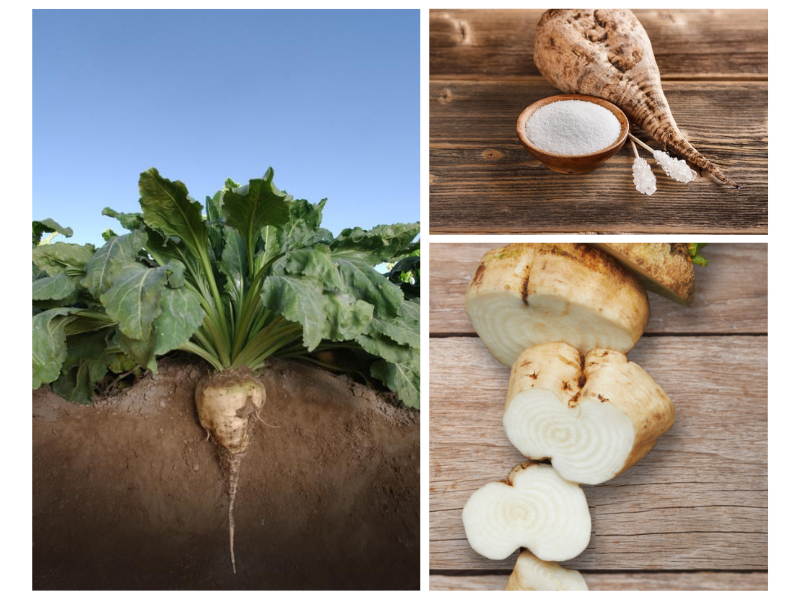Sugar beet vs sugar cane: How regional factors impact yield
Comprehending Sugar Beet Vs Sugar Cane: a Deep Study Their Handling and Applications
The comparison in between sugar beet and sugar cane exposes crucial differences in their handling and usage. Each crop has unique growing approaches that influence its geographic distribution. Sugar beetroots are largely refined into granulated sugar for various foodstuff, while sugar cane is often utilized in beverages. Recognizing these distinctions loses light on their functions in the food market and their economic relevance. Yet, the more comprehensive implications of their cultivation and processing require additional exploration.
Introduction of Sugar Beet and Sugar Cane
Sugar beet and sugar cane are 2 key resources of sucrose, each adding substantially to the international sugar supply. Sugar beet is a root vegetable, normally collected in cooler environments, while sugar cane is a high turf that flourishes in warmer tropical and subtropical regions. The handling of sugar beet includes cleaning, cutting, and removing juice, adhered to by filtration and condensation. In comparison, sugar cane processing includes squashing the stalks to remove juice, which is after that made clear and concentrated into sugar crystals.
Both plants are abundant in sucrose, but their composition varies a little, with sugar cane generally having a greater sugar material. Each source additionally contributes in biofuel manufacturing, with sugar beet often utilized for ethanol. While both are important for numerous applications, their distinctive development demands and processing methods affect their particular contributions to the sugar market.
Geographical Distribution and Farming Conditions
Sugar beet and sugar cane are grown in unique geographic areas, influenced by their certain climate and soil needs. Sugar cane prospers in exotic environments, while sugar beet is better matched for warm zones with cooler temperatures. Understanding these growing problems is necessary for maximizing production and making sure high quality in both crops.
Worldwide Expanding Regions
While both sugar beet and sugar cane are essential sources of sugar, their international growing regions vary markedly as a result of environment and dirt needs. Sugar beet thrives generally in warm regions, with considerable manufacturing concentrated in Europe, North America, and components of Asia. These locations usually include well-drained, fertile dirts that sustain the crop's growth cycle. On the other hand, sugar cane is largely cultivated in tropical and subtropical areas, with major production centers situated in Brazil, India, China, and Thailand. This crop flourishes in warm, moist environments that facilitate its growth. The geographical distribution of these 2 plants highlights the adaptability of sugar cane to warmer climates, while sugar beet stays dependent on cooler, pleasant problems for peak development.
Environment Needs
The climate requirements for sugar beet and sugar cane differ substantially, reflecting their adaptation to distinct ecological problems. Sugar beet flourishes in warm environments, calling for cool to mild temperatures, ideally ranging from 15 ° C to 20 ° C. It is sensitive to frost and benefits from well-distributed rainfall throughout its expanding period. This plant is normally grown in areas such as Europe and The United States And Canada.
Alternatively, sugar cane embellishments in exotic and subtropical environments, favoring warmer temperature levels in between 20 ° C and 30 ° C - Sugar beet vs sugar cane. It calls for bountiful sunlight and regular rainfall, making it fit to locations like Brazil, India, and Southeast Asia. The contrasting environment preferences of these crops noticeably affect their geographical circulation and farming methods
Soil Preferences
Both sugar beet and sugar cane call for details dirt conditions to thrive, their choices differ considerably. Sugar beetroots grow in well-drained, loamy dirts abundant in natural issue, with a pH varying from 6.0 to 7.5. These conditions are normally discovered in temperate areas, especially in Europe and North America. On the other hand, sugar cane favors deep, abundant soils with excellent water drainage and a somewhat acidic to neutral pH (6.0 to 7.0) This crop is mostly grown in tropical and subtropical environments, such as Brazil, India, and Australia. The geographic circulation of these crops shows their soil choices, as sugar beets are matched for cooler climates, while sugar cane flourishes in warmer, more moist atmospheres.
Gathering and Handling Techniques
In taking a look at the harvesting and processing strategies for sugar beet and sugar cane, unique methods arise for each plant. The comparison of harvesting approaches exposes variations in performance and labor demands, while removal methods highlight distinctions in the first handling phases. In addition, comprehending the refining processes is important for reviewing the high quality and return of sugar created from these 2 sources.
Gathering Methods Comparison
When taking into consideration the gathering approaches for sugar beet and sugar cane, distinct methods arise that mirror the unique qualities of each plant. Sugar beet collecting generally involves mechanical techniques, making use of specialized harvesters that uproot the beetroots from the ground, getting rid of tops and soil in the process. This method enables efficient collection and reduces plant damages. In comparison, sugar cane harvesting can be either hands-on or mechanical. Manual harvesting includes workers cutting the stalks short, while mechanical harvesting utilizes huge go to the website makers that cut, slice, and collect the cane in one procedure. These differences in collecting approaches highlight the versatility of each crop to its growing environment and the agricultural techniques widespread in their corresponding regions.
Extraction Strategies Overview
Extraction techniques for sugar production vary substantially in between sugar beet and sugar cane, showing their unique attributes and processing requirements. Sugar beets are normally collected utilizing mechanical farmers that cut the roots from the ground, adhered to by washing to remove soil. The beets are then sliced into thin items, called cossettes, to assist in the extraction of sugar via diffusion or warm water removal. In comparison, sugar cane is normally gathered by hand or device, with the stalks cut short. After harvesting, sugar cane undertakes crushing to extract juice, which is after that made clear and concentrated. These extraction approaches highlight the unique methods utilized based upon the source plant's physical features and the preferred performance of sugar extraction.
Refining Procedures Discussed
Refining processes for sugar from both sugar beet and sugar cane include a number of essential actions that ensure the last product is pure and suitable for usage. The raw juice removed from either source goes through explanation, where contaminations are eliminated utilizing lime link and heat. Following this, the juice is evaporated to concentrate the sugars. For sugar beetroots, the procedure typically consists of carbonatation, while sugar cane may go through a much more uncomplicated condensation approach. When focused, the syrup is subjected to condensation, generating raw sugar. Finally, the raw sugar is cleansed via centrifugation and further refining, causing the white granulated sugar generally found on store racks. Each action is crucial in making sure item quality and safety for consumers.
Nutritional Profiles and Health And Wellness Impacts

Health and wellness effects related to both resources mostly originate from their high sugar content. Extreme intake of sucrose from either source can lead to weight gain, oral problems, and raised risk of persistent illness such as diabetes and heart illness. Sugar cane juice, frequently eaten in its all-natural form, may give extra antioxidants and phytonutrients compared to refined sugar beet items. Inevitably, small amounts is type in using both sugar beet and sugar cane in diet plans to alleviate potential wellness dangers.
Economic Relevance and International Production
The economic value of sugar beet and sugar cane is significant, because view it both crops play crucial duties in the global farming landscape. Sugar cane, mostly grown in tropical and subtropical areas, accounts for approximately 75% of the world's sugar manufacturing. Countries like Brazil and India are leading producers, contributing substantially to their national economies with exports and regional consumption.

The worldwide sugar market is valued at billions of bucks, influenced by numerous elements consisting of climate, trade plans, and consumer need. Appropriately, both sugar beet and sugar cane are crucial for financial security and growth within the farming sector worldwide.
Applications in the Food Market
In the food sector, sugar beet and sugar cane serve vital duties, providing sweeteners that are essential to a broad selection of products. Both sources yield granulated sugar, which is a key ingredient in baked products, drinks, and confections. Sugar beet, typically favored in regions with cooler environments, is frequently located in refined foods such as jams, jellies, and dairy items. On the other hand, sugar cane is preferred in exotic regions and is regularly utilized in drinks like rum and soft drinks.
Past granulated sugar, both resources are likewise refined right into molasses, syrups, and other sweeteners, boosting taste accounts and boosting structure in different applications. Additionally, the spin-offs of sugar production, such as pulp and bagasse, are utilized in creating animal feed and biofuels, further showing their versatility. Overall, sugar beet and sugar cane are essential elements of the food market, influencing preference, structure, and overall item quality.
Environmental Considerations and Sustainability
As concerns concerning environment modification and resource depletion expand, the ecological effect of sugar beet and sugar cane cultivation has actually come under analysis. Sugar cane, commonly grown in tropical areas, can cause deforestation and environment loss, exacerbating biodiversity decrease. Furthermore, its cultivation regularly relies upon intensive water usage and chemical plant foods, which can contaminate regional rivers.
Conversely, sugar beet is commonly expanded in pleasant environments and may advertise soil health and wellness through plant rotation. However, it likewise deals with challenges such as high water intake and reliance on chemicals.
Both crops add to greenhouse gas emissions during handling, yet lasting farming methods are emerging in both fields. These include accuracy agriculture, chemical-free farming, and incorporated pest monitoring. In general, the environmental sustainability of sugar manufacturing remains a pushing concern, demanding continual evaluation and fostering of environment-friendly techniques to mitigate unfavorable effects on communities and neighborhoods.

Often Asked Concerns
What Are the Distinctions in Taste Between Sugar Beet and Sugar Cane?
The preference differences between sugar beet and sugar cane are refined yet unique. Sugar beet often tends to have a slightly earthier flavor, while sugar cane uses a sweeter, more aromatic account, attracting various culinary choices.
Can Sugar Beet and Sugar Cane Be Utilized Reciprocally in Recipes?
Sugar beet and sugar cane can typically be used mutually in recipes, though refined distinctions in flavor and structure might emerge. Substituting one for the other typically maintains the intended sweetness in cooking applications.

What By-Products Are Produced From Sugar Beet and Sugar Cane Handling?
The handling of sugar beets and sugar cane returns various by-products. These consist of molasses, pet feed, and biofuels. Each byproduct offers unique functions, contributing to farming and commercial applications beyond the key sugar removal.
How Do Sugar Beet and Sugar Cane Affect Dirt Wellness?
The effect of sugar beet and sugar cane on soil wellness differs; sugar beets can enhance raw material, while sugar cane may cause soil degradation otherwise managed correctly, affecting nutrient degrees and soil framework.
Exist Details Ranges of Sugar Beet and Sugar Cane?
Various specific varieties of sugar beet and sugar cane exist, each adapted to various environments and soil kinds. These varieties are grown for qualities such as yield, disease resistance, and sugar material, optimizing farming productivity.